"Strive not to be a success, but rather to be of value."
− Albert Einstein
Norman Borlaug invented shuttle breeding. It entailed using two different geographic locations to breed two generations of plants yearly. He did "summer" wheat breeding at the International Center for Maize and Wheat Improvement (CIMMYT) near Mexico City. In the winter he bred wheat at an experiment station in the Yaqui Valley of the northern Mexican State of Sonora. He loved the Yaqui Valley and its farmers. It was there that he felt most at home. He directed that his final resting places include the Yaqui Valley. To honor his wishes, his friends in the Yaqui Valley constructed a beautiful, international monument. The flags of 24 nations fly there and it provides a final resting place for their beloved friend. On 25 March 2010 more than 600 people from around the world attended the monument dedication at the "winter breeding" grounds of the experiment station outside of the city of Obregon, Mexico. As a further honor the experiment station was renamed The Norman E. Borlaug Experiment Station.
Dr. Norman Ernest Borlaug, the world’s most renowned plant pathologist and agricultural scientist, passed away on 12 September 2009. To honor their valued friend and world leader, the farmers and his other friends in the Yaqui Valley of the Mexican State of Sonora supported building of a final resting place. It is in the form of a permanent monument, a bronze statue of Borlaug and an urn vault. This international monument is located on an agricultural research station in the Yaqui Valley near the city of Obregon, in Sonora, Mexico. The formal dedication ceremony was held on March 25, 2010, Norman E. Borlaug’s birth date.
Norman Borlaug loved the Yaqui Valley and its people; they were his loyal friends. Indeed, for more than 40 years Norman Borlaug worked in and helped develop the Yaqui Valley both economically and educationally. Generations of valley residents knew him as their friend. Of the Yaqui Valley Borlaug said, "This is where I truly feel at home, and where I am at peace." It was his wish that his final resting places include this very special valley.
| |
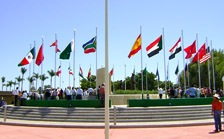
Fig. 1. The Norman E. Borlaug monument in the Mexican State of Sonora is an eternal resting place for Dr. Borlaug. To the right is the bronze statue of Borlaug standing among wheat plants. At the left rear is located a vault containing an urn of remains (all photos by Richard Zeyen). |
|
Thus, to fulfill Dr. Borlaug’s wish, the raised monument was built on a plaza located on the grounds of the Mexican National Institute of Forestry, Agriculture, and Livestock Research (INIFAP). This location is also the "winter breeding" grounds for the International Maize and Wheat Improvement Center (CIMMYT). Surrounding this international monument are 24 flags representing the principal countries where Norman Borlaug had the most impact. The flags are, in alphabetical order, those of: Afghanistan, Argentina, Australia, Bangladesh, Brazil, China, Egypt, Ethiopia, India, Iran, Iraq, Kenya, Mexico, Morocco, Nepal, Pakistan, Saudi Arabia, South Africa, Spain, Sudan, Syria, Tunisia, Turkey, and the United States of America (Fig. 1).
The monument is divided into two areas. In the front a bronze Borlaug statue overlooks a planting of "Siete Cerros" wheat. The monument is the creation of the artist Hector Martinez Arteche and was unveiled at the dedication ceremony by Norman Borlaug’s daughter, Jeanie Borlaug Laube (Fig. 2).
| |
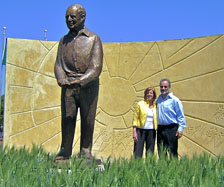
Fig. 2. Jeanie Borlaug Laube unveiled the bronze statue of her father, Norman Borlaug. Jeanie is standing with Hans-Joachim Braun (Director of CIMMYT Wheat Program in Mexico). |
|
Norman Borlaug’s statue is on an elevated platform. It depicts him with wheat heads in his hands. He is offering wheat to the world to alleviate hunger, lift people from poverty and misery, and provide them with prosperity and peace (Fig. 3).
| |
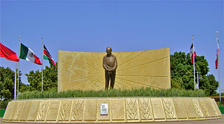
Fig. 3. The statue of Norman Borlaug stands overlooking a planting of "Siete Cerros" wheat. Borlaug’s hands are extended, and holding wheat heads. |
|
A decorated base surrounds the platform. The names of six wheat varieties that formed the foundation of the Green Revolution are stamped in the base. They are "Pitic 62," "Lerma Rojo 64," "Siete Cerros 66," INIA 66," "Sonalika," and "Yecora 70" (Fig. 4).
| |
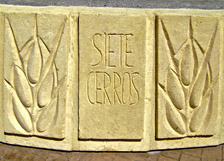
Fig. 4. Siete Cerros, one of six wheat varieties forming the colored concrete base of the raised platform. These wheat varieties were chosen because they formed the basis for the Green Revolution. |
|
In the back of the monument is an urn vault. It contains a portion of Dr. Borlaug’s ashes (Fig. 5). According to Dr. Borlaug’s wishes he will also lie at rest in Minnesota, where he earned his B.S., M.S., and Ph.D. degrees, and in Iowa where he was born, and where the World Food Prize Foundation he helped establish is located.
| |
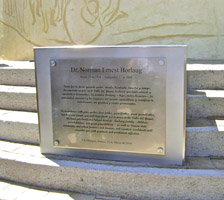 |
|
Fig. 5. The monument’s urn vault, and this inscription: "In accordance with your wishes, dear father, grandfather, great-grandfather, teacher and friend. You will henceforth rest in peace in the Valle del Yaqui, the land you loved and helped develop. The Borlaug family – children, grand-children, and great grandchildren – as well as the Sonora state community and wheat farmers, and farmers and scientists worldwide, will remember you with gratitude and permanent affection." |
|
The dedication of the monument was preceded on 24 March by a general CIMMYT field day. Field tours featured demonstrations of historic and current wheat lines and modern, sustainable growing practices. Field presentations were by various CIMMYT staff members, supervised by CIMMYT’s Wheat Program Director for Mexico, Dr. Hans-Joachim Braun (Fig. 2). Another smaller tour was arranged for diplomats unfamiliar with the entirety of the experiment station.
More than 600 people attended the formal dedication ceremony of the monument and the placing of the urn in its vault. Participants were from all parts of the globe. Formal testimonials featured the impact of Norman Borlaug and his colleagues on Mexico and the world. Among the speakers were Hector Larios (Secretary of State for Sonora, Mexico), Thomas Lumpkin (Director General of CIMMYT), Jeanie Borlaug Laube (daughter of Norman Borlaug), Antonio Gandra (President of the Board of Agricultural Research and Experimentation for Sonora – PIEAES), Francisco Javier Mayorga (Secretary of Agriculture, Livestock, Rural Development, Fisheries and Food for Mexico - INIFAP), Guillermo Padres (Governor of the State of Sonora), and Manolo Barro (Mayor of Cajeme County which includes the city of Obregon and most of the Yaqui Valley).
Ambassador Kenneth Quinn of the World Food Prize Foundation and CIMMYT alumni and staff joined with farmers, businessmen, and residents of the Yaqui Valley to celebrate the life of their esteemed friend and colleague. In an afternoon session all who wished, shared their personal memories of Norman Borlaug. Moving reminiscences and wonderful stories were heard. Most people shared stories about Norman Borlaug’s astounding work ethic, incredible dedication, and his humor, compassion, and advocacy for education.
One of the many stories told during the dedication revolved around that of Evangelina Villegas. In 1959 she was a promising student at Mexico’s National Polytechnic Institute in Mexico City. However she was faced with expulsion because her family could no longer afford her tuition. Dr. George Harrar (who headed the Rockefeller Foundation’s efforts in Mexico) heard of Evangelina’s potential and her plight. He hired her as a library assistant, and this enabled her to stay in college. She received her B.S. degree in Biochemistry, and then earned a Ph.D. from North Dakota State University in Cereal Chemistry and Plant Breeding. Dr. Villegas then spent much of her career as a cereal chemist evaluating Borlaug’s breeding lines for processing and baking quality. She also worked as a chemist with maize breeding programs. In 2000, Dr. Evangelina Villegas (Fig. 6), along with India’s Dr. Surinder K. Vasal, shared the World Food Prize for work on high protein maize.
Dr. Evangelina Villegas’s contributions do not end with science; she passed on the opportunities given to her. She took it upon herself to oversee an "Education Fund" established to help CIMMYT’s "Bird Boys." Bird Boys were local youngsters hired to keep birds from destroying valuable breeding stock growing in CIMMYT fields. Norman Borlaug believed talent is where you find it. He always talked to these youngsters and encouraged them to get an education. Evangelina’s efforts helped many of them pay for schooling. Many Bird Boys completed high school, and one of those, Reyes Vega, was a natural born logistics expert. He mastered wheat breeding and developed a protocol that greatly increased the "take" of wheat crosses. Reyes’s protocol is now a standard breeding procedure worldwide. Other Bird Boys went on to college and some did successful postgraduate work. One Bird Boy, Arturo Hernandez, received his Ph.D. degree from the University of Minnesota.
| |
Fig. 6. Dr. Evangelina Villegas, winner of the 2000 World Food Prize, tells her story of working with Norman Borlaug and what his encouragement and friendship meant. |
|
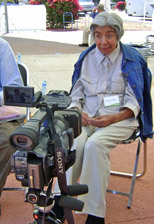 |
|
There was a final theme to the Borlaug memorial dedication day. Its genesis was in the historical collaboration between Yaqui Valley farmers, various agribusinesses, and their valued friend Norman Borlaug. Often, farmers and business people alone understood the benefits of the research conducted by Norman Borlaug and his colleagues. In the 1950s a decision was about to be made to move the Yaqui Valley "winter breeding" grounds elsewhere because the station was too small and lacked necessary infrastructure. However, valley farmers, assisted by the leadership of ex-Sonoran governor Rodolfo Calles, acted to keep Norman Borlaug and his research in their valley. When institutional and governmental support was not forthcoming, the Yaqui Valley farmers themselves obtained additional land, provided farm equipment, and upgraded infrastructure to make a research station for their valued friend Norman Borlaug. Their efforts kept the experiment station in the Yaqui Valley. Their faith in Norman Borlaug and his wheat was amply rewarded. Wheat yields in the Yaqui Valley quadrupled, transforming this valley into Mexico’s "breadbasket."

Fig. 7. Farmers putting up their sign thanking Dr. Borlaug. Sign sponsored by PIEAES – The Board of Agricultural Research and Experimentation of the State of Sonora. |
|
Yaqui Valley residents have great respect for their old friend and what he taught them. During the ceremony, the farmers displayed their own banner thanking Dr. Borlaug for teaching them the value of research and how to support it (Fig. 7).
This experiment station outside of Obregon, which the Yaqui Valley farmers made possible, now houses the CIMMYT winter breeding grounds and is part of the Mexican National Institute of Forestry, Agriculture, and Livestock Research (INIFAP). To honor Norman Borlaug and this historic experiment station, members of INIFAP with local and national support renamed the station Campo Experimental Norman E. Borlaug − The Norman E. Borlaug Experiment Station (Fig. 8).
| |
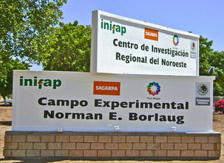
Fig. 8. Renaming of the northeast regional experiment station outside of the city of Obregon, Mexico, "The Norman E. Borlaug Experiment Station." |
|
Only a person like Norman Borlaug could inspire such deep love and intense loyalty. His many years in the Yaqui Valley made it home to him. He understood the Yaqui Valley’s people and they understood him. To them, Norman Borlaug was more than a world figure; he was a pragmatic, charismatic friend who helped them to develop the Yaqui Valley and brought it prosperity. He spoke Spanish fluently and truly cared about them and their future. Norman Borlaug greeted and spoke with and to all of them. He talked with and encouraged field hands, researchers, community leaders and local residents. When he could not be there he often telephoned and encouraged them. Norman Borlaug’s dedication and vision for harnessing science to benefit the Yaqui Valley and its farmers lives on as a core value in CIMMYT and INIFAP.
This wonderful, international monument and resting place in the Yaqui Valley is a tribute to Norman Borlaug. It is also a tribute to several generations of valley residents who knew, helped, and loved him. Now he will always remain one of them, their beloved and valued friend.
Additional Information and Resources:
APSnet Features
Norman Borlaug: Plant Pathologist/Humanitarian
Wikipedia
International Maize and Wheat Improvement Center
The Nobel Foundation
Norman Borlaug, The Nobel Peace Prize 1970
The Mathile Institute & Hunger Fighters
Freedom from Famine − The Norman Borlaug Story
University of Minnesota News Service
A Tribute to Norman Borlaug
University of Minnesota, Department of Plant Pathology
Norman Borlaug - Plant Pathologist/Humanitarian
The World Food Prize
Norman E. Borlaug: Founder
Durban House Publishing
The Man Who Fed the World (book by Leon Hesser)
Bracing Books: Borlaug
Volume 1: Right Off the Farm, 1914-1944
Volume 2: Wheat Whisperer, 1944-1959.
